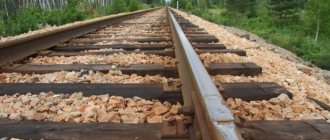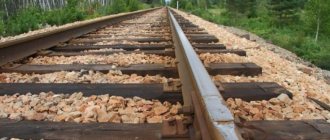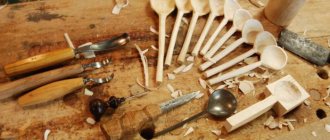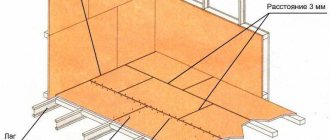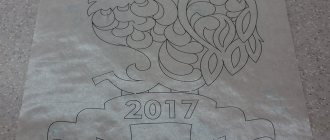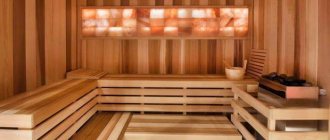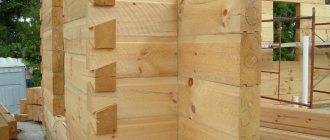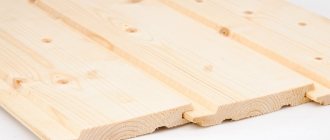Purpose of sleepers and requirements for them
Sleepers (rail supports) are used for:
- receiving pressure from the rails and transmitting it to the ballast layer;
- elastic processing of dynamic influences on the path;
- ensuring constant track width and, together with ballast, stability of the rail and sleeper grid in the horizontal and vertical planes.
In accordance with this, sleepers must have sufficient strength, elasticity, good resistance to mechanical wear and movement, be simple in shape, have the longest service life and the lowest cost in manufacturing and maintenance.
Wooden sleepers
Wooden sleepers predominate on the world's railways, since from a technical point of view they best meet the requirements for an under-rail base.
The main advantages of wooden sleepers are good elasticity, ease of manufacture and operation (transportation, tamping, changing), and high electrical resistance.
The disadvantages of wooden sleepers are their short service life with high load loads, and the great need for industrial wood, which is necessary for the diverse needs of the national economy.
Since January 1, 1966, wooden sleepers (Fig. 1) of two types have been laid on Russian roads:
- edged (A), in which all four sides are sawn;
- unedged (B), in which two opposite sides are sawn - beds.
Wooden sleepers are divided into three types:
- I – for main paths;
- II – for station and access roads (non-public railway tracks);
- III – for inactive paths of non-public use of industrial enterprises.
Rice. 1 – Types of wooden sleepers (cross sections)
Sleepers are made from pine, spruce, fir, cedar, beech and birch. The length of the sleepers is 2.75 m. For particularly heavy-duty sections, sleepers with a length of 2.8 m are supplied, and for sections with combined tracks of different gauges - 3.0 m.
Wooden sleepers are replaced due to rot and mechanical wear. These processes occur simultaneously and influence each other. The Russian Federation has adopted a system of selective replacement of sleepers, except for major repairs, in which sleepers are replaced entirely. Professor M.A. Chernyshev proposed to determine the average actual service life of wooden sleepers from the expression
where A is the total number of sleepers lying along the way;
m1, m2 – the number of unusable sleepers along the way according to field inspection data, respectively, at the beginning and at the end of the period (year, five-year plan);
n – number of sleepers laid on the track during the period tн;
tn – duration of observation.
The values of A, m1, m2 and n are taken from the technical passport of the track and technical reports.
Similar news
- Reinforced concrete sleeper Ш3: weight, size, length, width - description of all characteristics
- Railway wooden beams for turnouts: purpose, GOST, dimensions, weight
- Characteristics of reinforced concrete sleepers Ш1: dimensions, weight according to GOST
- Impregnated wooden sleeper type 1, 2: service life, how much it weighs, size according to GOST
- Types and sizes of reinforced concrete sleepers: weight, length and width of reinforced concrete supports on the railway
These advantages allow them to be used not only when laying access lines, but also in construction. The only problem is rotting: the joints with metal structures mounted on top sooner or later collapse, even despite treatment with antiseptics.
The cross-sectional geometry is given for rail supports whose timber moisture content does not exceed 22%. Since the operating requirements are not too stringent, some deviations from the established L/W/H are acceptable (usually ± 5 mm).
Dimensions of different types of sleepers
| Variety | Thickness h | Height of sawn sides h1 | Width | Length | ||
| Top plate | Lower b' | |||||
| b | b' | |||||
| I | 180±5 | 150 | 180 | 210 | 250±5 | 2750±20 |
| II | 160±5 | 130 | 150 | 195 | 230±5 | 2750±20 |
| III | 150±5 | 105 | 140 | 190 | 250±5 | 2750±20 |
Attention, all these parameters are relevant for coniferous species (for spruce, fir, pine, larch) and birch with a humidity level of up to 22%. If this indicator exceeds the norm, it is necessary to give allowances for shrinkage, in accordance with GOSTs 6782.1-75 and 6782.2-75. Moreover, the cross-sections of the rail supports also comply with the stated requirements, and here we come to a separate subtype of track structural elements, used on relaxed and low-activity lines and as access tracks in various factories and factories.
The thickness and height of wooden sleepers increase with improvement in class, which indicates a clearly structured gradation of areas of application. At the same time, the tolerances for the width of the bottom layer remain the same - from 5 to 20 mm, which makes it possible to unify and build safe crossings on the track.
The geometric features are summarized in Table 1 above), so we just have to look at them again and draw brief conclusions:
- The rise of the sawn sidewalls increases with the improvement of the class - if for the 3rd it is 105 mm, then for the 1st it is already 150 mm, which helps to ensure the proper strength of the rail support.
- Width and thickness also obey this law, which makes the final product somewhat heavier, but has a positive effect on resistance to stress.
- The length of the wooden railway sleeper does not change with increasing type, remaining 2750 mm, and such unification significantly facilitates the process of joining sheets for different purposes.
Standard requirements
Reinforced concrete sleepers are manufactured in accordance with regulatory documents with strictly observed shapes and sizes. Strength and other indicators of reinforced concrete sleepers are reflected in GOST 33320–2015. These are products whose performance characteristics are subject to the following requirements:
- Strength parameters. The force transmitting pre-tension occurs immediately after the product is manufactured.
- Concrete parameters. The mixture must have the highest degree of uniformity of consistency.
- Exact shapes and sizes. Compliance with these parameters is typical for these designs. There are strict tolerances on sleeper elements, and compliance with specified standards of connection points with rails is verified.
Table. Types of wooden sleepers.
| Sleeper type | Thickness h, mm | Height of sawn sides h1, mm | Width, mm | Length, mm | ||
| upper surface no less | bottom layer | |||||
| b | b' | b1 | ||||
| I | 180±5 | 150 | 180 | 210 | 250±5 | 2750±20 |
| II | 160±5 | 130 | 150 | 195 | 230±5 | |
| III | 150±5 | 105 | 140 | 190 | 230±5 | |
Sleepers according to their purpose are divided into three types: I - for main tracks of the 1st and 2nd classes1, as well as for tracks of the 3rd class with a freight load of more than 50 million t.km gross/km per year or train speeds of more than 100 km/h II – for main tracks of the 3rd and 4th class, access tracks with intensive work, receiving and sorting tracks at stations; III – for any 5th class tracks, including station tracks, inactive access roads and other tracks with shunting and export traffic. The dimensions of wooden sleepers are established for wood with a moisture content of no more than 22%. With higher wood moisture content, sleepers must have allowances for shrinkage in thickness and width for coniferous species in accordance with GOST 6782.1-75, and for deciduous species in accordance with GOST 6782.2-75.
READ Plywood - production and purpose
Specifications
According to interstate standard 78-2004:
- The location of the lower and upper layers is mutually parallel, with tolerances strictly within the specified standards for LxW.
- End cuts are only perpendicular to the longitudinal axis, with a bevel not exceeding 20 mm in thickness.
- During production, it is necessary to clean the ash areas from bast and/or bark.
- Knots and knots must be cut off, avoiding nicks and cuts on the upper side or making them no wider than 40 mm and no deeper than 20 mm in other cases.
- Sleepers impregnated with ultan or another product in accordance with GOSTs 20022.0 and 20022.5 must first be protected from cracking - in a manner accepted by the manufacturer and in accordance with the general instructions for the maintenance of VSP elements.
- The marking must be obvious and clear and must be a branding or paint designation on the end.
Classification of wooden sleepers.
Wooden ones are classified into several types and are manufactured in accordance with GOST 78-2004.
Depending on the cross-sectional shape, sleepers are:
– edged (cut on four sides);
– semi-edged (on three sides);
– unedged (top and bottom).
Depending on their intended purpose, they are:
– for main paths;
– station and access roads;
– for small access roads of industrial enterprises.
Wooden sleepers are impregnated with special coal oils or specialized antiseptics. In certain cases, instead of sleepers, solid block layers in the form of slabs or frames made of reinforced concrete or steel are used.
Humidity factor
The actual size of a railroad tie made from wood may depend on the moisture level of the material. What does it mean? The fact is that the corresponding values are relevant for humidity not exceeding 22%. If this indicator is greater than the specified value, then the dimensions of the sleeper should be considered taking into account the necessary allowances for drying. Its value depends on the type of wood - coniferous or deciduous. A similar requirement is also established for the cross sections of composite sleepers.
Production of wooden sleepers
The most popular and most affordable materials for making sleepers today are timber.
Most often, impregnated sleepers are treated with two main types of antiseptic preparations - water-soluble and oil-based. The first type is often a solid compound that needs to be diluted with liquid to a certain consistency. Oil-based antiseptics are nothing more than a product of dry distillation of timber and coal. They are used in their natural form and can also be diluted with other oily liquids.
Before purchasing this material, you need to carefully study the certificates at the enterprise, because the length of the operating period of the final products and the effectiveness of the implementation of the functions assigned to them directly depend on the quality.
Types of wooden sleepers. Why does wood continue to be the best material for sleepers?
Sleepers are horizontal supports that allow the rails to be positioned at equal distances from each other. Meanwhile, maintaining the specified distance is critically important.
Today sleepers are made from various materials:
- tree;
- metal;
- plastic, etc.
It should be noted that despite the significant development of industry, wooden sleepers continue to be the most preferred in use. After all, they have all the necessary technical parameters and are as affordable as possible.
Wooden sleepers can be divided into the following classes: edged, half-edged, unedged.
Among the disadvantages of using wooden sleepers, only one can be noted. They rot where they meet the rails. However, there is a simple way to avoid this problem - the use of antiseptic solutions.
In Russia, pine is considered such wood. The fact is that this is the most common wood, which means it is the cheapest. In Western countries, cedar, maple and even eucalyptus can also be used to produce sleepers.
The main property that wooden sleepers should have is plasticity. When a train passes along the rails, they must keep them at the same distance from each other.
However, if hard metal is used instead of wood, vibration will occur in it (malignant). Wood dampens vibration without any problems. More precisely, it passes through it, but there is no negative impact.
The only thing you should pay attention to is local rotting of the tree. If this happens, it is strongly recommended to replace the sleeper with a new one.
Unedged sleepers rot the least. However, they are much more difficult to install. It will not be possible to replace them within ten minutes. Meanwhile, plastic sleepers are being actively introduced in Europe. They are more durable than wooden ones, but also much more expensive.
Despite this, in the long term (tens of years) they turn out to be more practical.
The video will demonstrate how sleepers are made today:
Divisions of TVS JSC
| TransWoodService Address: Moscow, st. Novaya Basmannaya, 19, building 6 | Bogdanovichsky ShPZ Address: Sverdlovsk region, Bogdanovich, st. 8 March, no. 17 | Bologovo ShPZ Address: Tver region, Bologoe, st. Shpalozavodskaya, 1 |
| Zelenodolsk ShPZ Address: Republic of Tatarstan, Zelenodolsk, st. Football, 8 | Orenburg ShPZ Address: Orenburg, Korostelev Brothers Avenue, 60a | Reshotinsky ShPZ Address: Krasnoyarsk region, Nizhneingashsky district, Nizhnyaya Poima village, st. Smolozavodskaya, 46 |
| Taishet ShPZ Address: Irkutsk region, Taishet, st. Gagarina, 114 |
Wooden railway sleepers
Products called sleepers are used as supports for rails for various purposes. The following materials are used for their manufacture: concrete, wood, metal, modern synthetic materials. Wooden sleepers are considered the cheapest to produce. They were the first to be used for laying railway tracks. Wooden sleepers have a number of advantages that allow them to be used quite widely. They are used to fasten rails on main and secondary tracks. Various types of wood are used for production. The production technology and final cost depend on this. Currently, they have been replaced by railway sleepers made of other materials. However, wooden products are still used in various fields.
Advantages of this type of wood
Why is this unusual material attractive to a private developer?
- It is cheap, because used products are usually purchased.
- Holds any fastener well.
- The impregnated railway wooden product perfectly withstands many “frost-heat-freeze” cycles without visual damage.
- The material is flexible and copes well with dynamic loads.
In production, this lumber is made only from coniferous wood.
Overall dimensions and weight of wooden railway sleepers
The accepted standard establishes the geometric dimensions of a wooden sleeper. For all types, the sleeper length is set to 2750 mm. The permitted tolerance is 20 mm. The weight of the wooden sleeper will depend on the other dimensions. The height varies from 150 mm for the first type to 105 mm for the third. The width is determined by the shape and design. These parameters determine the purpose of the railway sleeper and its operating conditions. How much the railway option weighs depends on all the listed parameters. After impregnation, the weight increases slightly. The weight of one sleeper depends on its design. The mass of a wooden sleeper of the first type is 85 kg. It must withstand the heaviest loads. The weight of the second type does not exceed 80 kg. The dimensions of wooden sleepers in the standard are specified taking into account the condition of the wood. Humidity should not exceed twenty-two percent. Therefore, sleeper sizes may differ in one batch, but within tolerance. Before production begins, the dimensions of future products are set. Particular attention is paid to this parameter thickness. It must be constant along the entire length.
Geometric characteristics (sizes of sleepers) and classification are given based on the requirements established by the state standard. For example, GOST 78-2004 wooden sleepers for broad gauge railways combines all the characteristics of finished products. For special routes, their own standards have been developed. GOST 22830-77 wooden sleepers for the subway specifies the individual parameters necessary for their operation in these specific conditions. Each standard is consistent with other guidance documents consistent with the operating rules of the various tracks. GOST imposes certain restrictions on wooden sleepers regarding their area of application. Particular attention is paid to the choice of coating that is applied to the surface to improve their technical characteristics.
READ What types of lumber are there?
Length of bars: range of permissible values
But what are the length of the timber? In contrast to the standards regulating the size of wooden (railway) sleepers, when all values depend on the type of the corresponding element, they assume fairly strict compliance with established standards; in the case of beams, the length criteria are common for all their types. Moreover, the standards do not establish a specific indicator, but an interval - from 3 to 5.5 meters with a gradation of 0.25 m with permitted deviations within 20 mm.
Methods for processing wooden sleepers
Before forming the rail and sleeper lattice, wooden structures are treated with special chemical compounds. Why is this necessary? Without impregnation, railway sleepers crack faster under the influence of temperature, humidity and load on the track.
In order for the composition to penetrate into hard-to-reach areas, the following treatment methods are used:
- Piercing. The method involves deliberately creating a series of small cracks before impregnation with creosote, which reduces stress in the peripheral zone. At the same time, the strength of the sleepers themselves may decrease slightly (by 8%).
- High pressure. The wood is dried and placed in an autoclave, after which the GOST “vacuum-pressure-vacuum” technique is applied. Compositions used: creosote, coal oils, antiseptics, Elemsept.
- Low temperatures. Preliminary pricking of sleepers is required to improve the quality of impregnation of difficult-to-impregnate zones and increase service life (punctures form small cracks, reducing stress in the peripheral zone, and eliminating the appearance of deep cracks). Water-based emulsion antiseptics and accelerated atmospheric drying are used. The method is considered one of the most environmentally friendly due to minimizing emissions into the atmosphere.
Processing techniques
They represent several schemes for influencing the structure with pressure (D) and vacuum (V). The current option today is D-D-V:
- To achieve the required penetration depth, the rock is pre-pricked.
- The workpieces are placed in a chamber from which air is pumped out.
- Then the oily composition is poured there.
- The product impregnates the pores of the wood.
- The final stage is drying.
To protect the array from rot, use the following liquid compositions:
- Creosote is a distillate of coal or charcoal with a tar mixture. The impregnation is cheap, but extremely poisonous. The tree turns black after it.
- Elemsept - includes oxide compounds containing copper, chromium and arsenic inclusions. Less toxic, gives the timber a light shade of green.
- ZhTK – stands for thermal condensation liquid. Although it is the result of oil distillation, it practically does not emit toxic fumes. The exact composition is not publicly available. It practically does not stain wood.
- Ultan is a water-based product. Penetrates well inside the array, giving it a green color. Destructive for pests that feed on wood. Generally safe for humans and animals.
What are sleepers impregnated with: types of compositions, their pros and cons, harm to health
Finding out what sleepers are impregnated with is advisable in different situations, for example, when you want to use such wood in construction or you have to stay in close proximity to railway tracks for a long time.
The cost of wooden blanks used in laying the railway is very low, but this cheap wood has an insufficient service life. Here it is worth adding extremely aggressive conditions of use: constant vibration, contact with atmospheric agents and soil, high pressure.
The quality and characteristics of finished sleepers are regulated by GOST 78-2004. In order for the service life of products to comply with these standards, they are impregnated with special compounds that significantly increase the potential of wood. Such chemical “cocktails” reliably protect the fibrous structure of products from the destructive effects of moisture and physical wear.
Railway sleepers are operated in unfavorable conditions
In addition to creosote, a classic example of a protective mixture for this industry, the chemical industry offers to take advantage of relatively new names - Elemsept and ZhTK.
Creosote is a classic impregnation for railway sleepers
Wooden blanks have been treated with this composition for more than 50 years; the toxic liquid is extracted from charcoal and coal through tar distillation.
Creosote contains dangerous components such as phenolic ethers and phenol.
Sleepers impregnated with such a mixture acquire a characteristic black tint with noticeable admixtures of brown, and there is a strong odor reminiscent of diesel fuel. Despite the fact that the compound is toxic, the level of “questionable” impurities allows it to be used in the laying of railway tracks (if assessed only within the framework of government regulations).
The reason for the widespread use of this solution is its operational feasibility - impregnation really prevents premature destruction of wood, has a low cost and a comprehensively thought-out application technology over several decades.
Railway sleeper impregnated with creosote
It is a salt-free type of antiseptic; it contains concentrated oxides of chromium, arsenic, and copper. Sleepers are impregnated with this product, previously diluted with water, using a special technique that alternates exposure to vacuum and pressure. As a result, the workpieces acquire a greenish tint. The substance is low toxic and has no specific odor.
The substance is produced in powder form; autoclaves are needed to impregnate the wood with the diluted substance. The whole procedure comes down to three key steps:
As a result, the active composition penetrates at least a 2-mm layer of wood. The advantage of the solution is the high quality of impregnation.
Thermal condensation liquid is one of the results of oil production; its production recipe and composition are protected by patent law. Light wood impregnated with fatty acids acquires a brownish tint, larch and similar species become dark brown. The substance does not smell and does not emit toxic compounds.
Unlike creosote, the substance does not create a risk of developing cancer in humans; with the help of thermal condensation liquid, a more aesthetic image of the workpiece can be achieved. The impregnation does not form compactions or clots, and the surface of the sleepers does not become sticky. The use of liquid fuel and creosote creates an almost identical wood service life, but the first solution is much safer.
Sleepers treated with thermal condensation liquid
Is it possible to build with treated sleepers?
This building material is attractive because it is extremely cheap, so many craftsmen wonder whether it is worth using it for the construction of domestic or residential structures. The first thing that raises doubts is the smell of creosote (such impregnation is the most common), which they try to mask with improvised means. But we must not forget about the health hazards that such compounds pose. Therefore, it is better to refrain from such savings even when building a garage or utility rooms.
Creosote, Elemsept, ZhTK are key variations of compounds used to give sleepers durability and resistance to the destructive effects of the natural environment. They are used when laying railways, since in such conditions they comply with government safety standards and justify potential risks due to decent performance properties.
Application and dimensions of impregnated wooden sleepers type 1
It is used for laying the most critical sections - the main railway tracks experiencing maximum loads - and therefore must be of increased strength, which is reflected both in its dimensions and in its price - it costs more than other options, since the material on it production takes more.
a) edged; b) half-edged; c) unedged.
Its mass is 85 kg, it is 5 kg heavier than the type 2 (which we will consider in detail below). This difference is precisely ensured by the width increased by 2 cm. As a result, the increased load on the soil cushion does not become critical, but it helps to avoid deformations. It is this geometry that has been tested in practice and is therefore still indicated as relevant in interstate standards. Those parameters that do not fall under standard LxWxH, but are still quite important, deserve special attention. This:
- height of sawn sides – 150 mm;
- thickness – from 180 to 185 mm.
| Parameter | Indicator, mm | ||
| Length | 2750 ± 20 | ||
| Width across face | |||
| Lower | Upper | 250-255 | 180 and 210 |
| Climb | 180 | ||
READ What is lumber?
Thanks to this geometry ratio, they are able to withstand severe impacts for a long time without experiencing deformation.
Disadvantages of the product
The lumber in question also has a clear drawback. This is an unpleasant odor due to phenolic fumes contained in creosote. The smell, of course, dissipates over time (within about 50 years), but usually it is necessary to take the necessary measures to localize it. These include the following:
- insulation of impregnated parts with polyethylene;
- siding cladding;
- plastering walls;
- brick cladding.
Sometimes these measures are not effective. And therefore sleepers are almost never used as a building material for residential buildings .
They often go to the construction of outbuildings (baths, sheds, outbuildings). When constructing these projects, they are not bad as a building material, given the suitable weight and dimensions of a standard railway impregnated wooden sleeper.
Contents of the article
02/21/2020Egor11
Impregnated wooden sleeper (type 2), dimensions, weight
Impregnated wooden sleeper (type 2)
Weight, kg……………………….. 80
Size, mm……………………….. 2750x230x160
Unit Measurements………………………..pcs.
Wooden sleepers that have undergone the process of impregnation with an antiseptic are in full compliance with the state standard number GOST 78-2004 (GOST 78-89). This standard also states that sleepers of this type are divided into the following subtypes: - edged; - unedged; - semi-edged.
In the production of sleepers of the second type, various types of wood are used, such as pine, larch, birch, spruce and fir.
Type 2 wooden sleepers are used in quieter conditions - they are installed at stations and access roads. It is thinner than type 1 sleepers, although it has the same length and is made from the same material, similarly pre-dried and impregnated with special compounds. The main difference is what size of wooden railway sleeper in terms of width, height and thickness is permissible in the case of manufacturing type 2 sleepers. They have the following parameters:
- Thickness - 160-165 cm;
- The height of the sawn sides is exactly 130 cm;
- The width of the upper layer is 150 and 295 cm;
- The width of the bottom layer is 230-235 cm.
You can find out prices for both types of railway sleepers by contacting us by phone. manufactures impregnated sleepers of all types in strict accordance with GOST.
Repair
Can be carried out without removing supporting structures from the path, in this case:
- Worn parts are removed, burrs are cleaned, after which the treatment areas are coated with coal oil (or other suitable composition).
- During alterations, bushings are installed at a screw joint or fastening plates at a crutch joint.
- Cracks and holes from fasteners are also protected from moisture and pests.
- At the ends, the lower surface is reinforced with U-shaped brackets (6 or more of them are needed).
Used wooden railway sleepers impregnated with antiseptic agents are removed from the track and replaced. They are considered unsuitable for further use when their damage exceeds the tolerances and/or when they lie in a row in quantities of at least 3 pieces. Before replacing them, it is necessary to limit the speed of movement in the area to the minimum possible.
Production of wooden sleepers
The most popular and most affordable materials for making sleepers today are timber.
Most often, impregnated sleepers are treated with two main types of antiseptic preparations - water-soluble and oil-based. The first type is often a solid compound that needs to be diluted with liquid to a certain consistency. Oil-based antiseptics are nothing more than a product of dry distillation of timber and coal. They are used in their natural form and can also be diluted with other oily liquids.
Before purchasing this material, you need to carefully study the certificates at the enterprise, because the length of the operating period of the final products and the effectiveness of the implementation of the functions assigned to them directly depend on the quality.
Compositions that are used to impregnate raw materials.
The regulations governing railway construction require the use of wooden sleepers for laying tracks, which must be impregnated with antiseptic solutions. After the sleeper is impregnated, its cost does not increase significantly, but indicators such as durability and reliability increase significantly. Today, in production, the autoclave impregnation method is most often used, because it guarantees the penetration of the solution to the required depth.
For a long time, experts used a substance such as creosote. This is the name given to coal tar oil solution. Creosote contains phenol particles, which eliminate microorganisms that have a detrimental effect on timber. At the same time, the use of this solution increases the level of flammability of timber. Such sleepers have an unpleasant aroma; painting such raw materials is impossible.
Sawing sleeper ridges
This technological operation (sleeper cutting) is carried out on the basis of GOST 8486-86. Depending on the size of the ridge, appropriate cutting schemes have been developed. Production productivity largely depends on the diameter of the log and the chosen pattern. The main task of choosing the right scheme is to reduce the amount of waste when cutting. Currently, seven basic and more than forty modified rational cutting schemes have been developed. They are designed for the use of sleeper logs with a diameter of 255 to 700 millimeters. These schemes can be changed depending on the specific conditions of the cut being made.
Reinforced concrete sleepers: classification
An alternative to wooden sleepers can be reinforced concrete sleepers. These products are used on main tracks. They belong to the prestressed category. They are used when laying rails of types P75, P65, and P50. There are quite a lot of reasons for classifying reinforced concrete sleepers:
- according to the type of fastening to the rails;
- according to the type of prestressed reinforcement;
- according to electrical insulating characteristics;
- in terms of manufacturing quality.
In this case, we are interested in the first criterion - the method by which reinforced concrete sleepers are attached to the rails. The dimensions of the product and its other most important characteristics are determined based on the characteristics of the corresponding mechanism. So, depending on the type of fastening to the rails, sleepers are:
— type Ш1, intended for separate fastening using bolts by fixing the lining on the sleeper;
- type Ш2, intended for inseparable fastening using bolts by attaching not only the lining, but also the rail to the sleeper;
— type Ш3, intended for inseparable fastening using bolts by direct attachment to the rail sleeper.
Dimensions of railway sleepers according to GOST
Geometric characteristics (sizes of sleepers) and classification are given based on the requirements established by the state standard. For example, GOST 78-2004 wooden sleepers for broad gauge railways combines all the characteristics of finished products. For special routes, their own standards have been developed. GOST 22830-77 wooden sleepers for the subway specifies the individual parameters necessary for their operation in these specific conditions. Each standard is consistent with other guidance documents consistent with the operating rules of the various tracks. GOST imposes certain restrictions on wooden sleepers regarding their area of application. Particular attention is paid to the choice of coating that is applied to the surface to improve their technical characteristics.
Use of sleepers in private construction
Why is there a need to use them at all? As a rule, a poor financial situation forces the developer to look for an alternative material for construction.
- Railway impregnated wooden sleepers are very often used by private owners as timber due to its optimal dimensions and suitable weight.
- Some enterprising owners build separate structures entirely from sleepers. Such houses are warm in winter and cool in summer heat, because... This building material has a suitable heat capacity. It is not susceptible to the “diseases” of conventional lumber: invasion of fungus, insects or rot.
- Another option is to use sleepers - it is sawn into boards, which are subsequently used for lining the external or internal surfaces of the structure. The size and weight allows for sawing.
Length and other overall dimensions of wooden railway sleepers
They have long been standardized to provide practical advantages of rail supports, including:
- excellent processability of environmentally friendly material;
- maintaining high elasticity with relatively low weight;
- a serious margin of resistance to temperature changes and seasonal changes in heating/cooling cycles;
- interaction with the ballast cushion, which does not lead to destruction of the VSP;
- a wooden sleeper is a dielectric.
